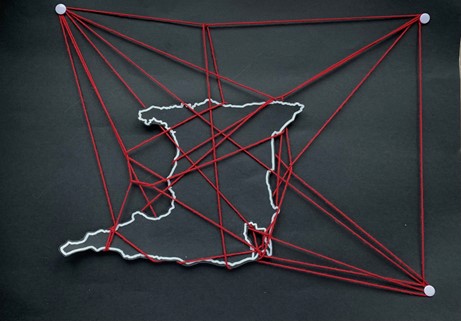Historical Figures and Events
“The Perpetual Search” – Luna Njoku Dominguez

In week 3, both Dionne Brand and Saidiya Hartman attempted to define the impossible experience of attempting to trace an origin which has been displaced by the transatlantic slave trade. This map is an attempt to represent the entanglement of pasts and migrations (forced and later voluntary) which produce identities and global dynamics but which may nonetheless not ever lead to a definitive origin within which identity is rooted and towards which this identity can be traced. While Hartman in Lose your Mother draws attention to the loss of a motherland and the sense of “homelessness” this evokes (31), in A Map to the Door of No Return Brand refers to diaspora as “the sea inbetween”, marking a sense of displacement within this “inexplicable space” for the descendants of slaves (25). This map, taking Brand’s work as its central focus, is an attempt at reorientation, seeking identity in spite of the absence of a traceable origin. I seek to represent the island of Trinidad as Brand’s physical place of origin, while simultaneously expressing the arbitrariness of this origin which she herself identifies (57). I intend to shift the focus towards the significance of entanglement between diasporic and (post)colonial identities, exemplifying the ways in which these disparate locations are intrinsically linked with each other in a mutually influential dynamic which leaves none of them untouched or unchanged by the implications and consequences of the transatlantic slave trade. Although the idea of a motherland may bring comfort in the face of a violent and brutal history which displaces origins, Brand and Hartman teach us that the search for origins may lead one to emptiness.
For this purpose, I have chosen to lend emphasis to the silhouette of Trinidad, and specifically the village of Guayaguayare as the birthplace of Brand. However, the three surrounding points on the map represent the additional presence of Canada, Britain, and the West African coast in their geographical and historical relation to Trinidad. The upper left position marks Brand’s emigration to Canada; the upper right position symbolises the dominant presence of British colonialism; and the position on the lower right hand side indicates the West African coast from which slaves were imported. The thread which runs across, through, and around the island serve to symbolise not just the actual journeys of colonisers and their slave ships, but also the historical, cultural, ethnic, and spiritual ties between these places and the spaces between. The red thread serves to signify the entanglement which was born from the violence of colonisation and slavery, and which still persists today. The predominance of black is a reference to Brand’s claim that the Caribbean descendants of slavery “have no ancestry except the black water and the Door of No Return” (57). Brand often recalls imagery of the sea as a place of origins, yet no central point can be defined or traced back to a root, thus, the ‘black water’ is represented as engulfing the entirety of the map. Similarly, the thread has no end or beginning, it simply entangles itself in a multidirectional loop, reminiscent of Brand’s image of the the Saragasso sea as a “tangle” (63). The gap which has been carved out of Guayaguayare brings parts of the thread into contact, yet, it is impossible to know if multiple threads are converging at this point, or if a single thread emerges here. In this way I intend to symbolically represent the threads of history which cannot be neatly traced to a motherland or ancestral origins due to the violent rupture and erasure which slavery entailed; “Our origins seemed to be in the sea. It had brought the whole of Guayguayare there from unknown places, unknown origins. Unknown to me at the time and even more unknown now” (17).
Works Cited
Brand, Dionne. A Map to the Door of No Return: Notes to Belonging. Vintage Canada, 2001.
Hartman, Saidiya. Lose Your Mother: A Journey Along the Atlantic Slave Route. First, Farrar, Straus and Giroux, 2008.

